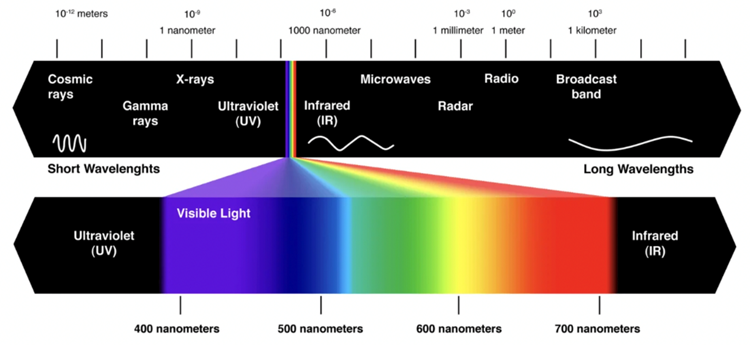Lesson 14 - The Fascinating World of the Visible Light Spectrum
Oct 24th 2023
Introduction
The visible light spectrum is a captivating aspect of our world, defining how we perceive color and the world around us. This spectrum, which ranges from violet to red, plays a crucial role in the functioning of night vision technology. In this blog, we'll take a deeper dive into the visible light spectrum, understanding its properties and significance.

The Visible Light Spectrum
The visible light spectrum is a segment of the broader electromagnetic spectrum. This spectrum represents all forms of electromagnetic radiation, with each type characterized by a unique wavelength and frequency. Within this vast spectrum, the visible light spectrum is the narrow band of light that our eyes can detect.
The visible light spectrum comprises various colors, each corresponding to a specific wavelength:
- Violet: With the shortest wavelength in the visible spectrum, violet light ranges from about 400 to 420 nanometers (nm). Objects that appear violet reflect and absorb light in this range.
- Blue: Following violet is blue light, spanning from approximately 420 to 490 nm. Many natural and synthetic objects reflect blue light.
- Green: Green light occupies the range from 490 to 570 nm. It's the predominant color in plant life and is responsible for the lush greenery we see.
- Yellow: Moving along, yellow light ranges from 570 to 590 nm. Sunlight appears yellow when it combines with other colors in the atmosphere.
- Orange: The wavelength of orange light falls between 590 and 620 nm. This color is often seen in sunsets and fruits like oranges and carrots.
- Red: At the far end of the visible spectrum, red light has wavelengths ranging from 620 to 700 nm. Red is a striking and warm color often associated with strong emotions.
The Role of the Visible Light Spectrum in Night Vision
Night vision technology relies on the visible light spectrum indirectly. Traditional night vision devices, such as image intensifiers, amplify existing ambient light to create visible images. While they can work in extremely low-light conditions, they are not completely reliant on the visible spectrum.
In contrast, thermal imaging cameras operate outside the visible spectrum. They detect heat emissions from objects and create images based on temperature differences, allowing them to function in total darkness.
Conclusion
The visible light spectrum, spanning from violet to red, is the cornerstone of how we perceive the world in color. While night vision technology primarily operates outside this spectrum, understanding it enriches our appreciation of the science behind night vision. The ability to see and explore the world in low-light conditions has opened new horizons, all thanks to the remarkable innovations of companies like Armasight.
